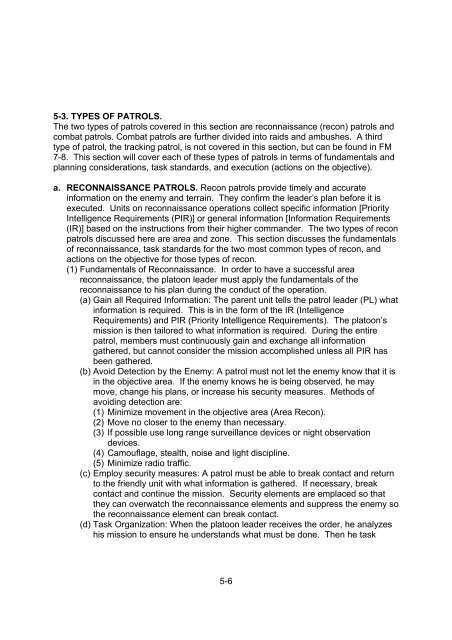Create successful ePaper yourself
Turn your PDF publications into a flip-book with our unique Google optimized e-Paper software.
5-3. TYPES OF PATROLS.<br />
The two types of patrols covered in this section are reconnaissance (recon) patrols and<br />
combat patrols. Combat patrols are further divided into raids and ambushes. A third<br />
type of patrol, the tracking patrol, is not covered in this section, but can be found in FM<br />
7-8. This section will cover each of these types of patrols in terms of fundamentals and<br />
planning considerations, task standards, and execution (actions on the objective).<br />
a. RECONNAISSANCE PATROLS. Recon patrols provide timely and accurate<br />
information on the enemy and terrain. They confirm the leader’s plan before it is<br />
executed. Units on reconnaissance operations collect specific information [Priority<br />
Intelligence Requirements (PIR)] or general information [Information Requirements<br />
(IR)] based on the instructions from their higher commander. The two types of recon<br />
patrols discussed here are area and zone. This section discusses the fundamentals<br />
of reconnaissance, task standards for the two most common types of recon, and<br />
actions on the objective for those types of recon.<br />
(1) Fundamentals of Reconnaissance. In order to have a successful area<br />
reconnaissance, the platoon leader must apply the fundamentals of the<br />
reconnaissance to his plan during the conduct of the operation.<br />
(a) Gain all Required Information: The parent unit tells the patrol leader (PL) what<br />
information is required. This is in the form of the IR (Intelligence<br />
Requirements) and PIR (Priority Intelligence Requirements). The platoon’s<br />
mission is then tailored to what information is required. During the entire<br />
patrol, members must continuously gain and exchange all information<br />
gathered, but cannot consider the mission accomplished unless all PIR has<br />
been gathered.<br />
(b) Avoid Detection by the Enemy: A patrol must not let the enemy know that it is<br />
in the objective area. If the enemy knows he is being observed, he may<br />
move, change his plans, or increase his security measures. Methods of<br />
avoiding detection are:<br />
(1) Minimize movement in the objective area (Area Recon).<br />
(2) Move no closer to the enemy than necessary.<br />
(3) If possible use long range surveillance devices or night observation<br />
devices.<br />
(4) Camouflage, stealth, noise and light discipline.<br />
(5) Minimize radio traffic.<br />
(c) Employ security measures: A patrol must be able to break contact and return<br />
to the friendly unit with what information is gathered. If necessary, break<br />
contact and continue the mission. Security elements are emplaced so that<br />
they can overwatch the reconnaissance elements and suppress the enemy so<br />
the reconnaissance element can break contact.<br />
(d) Task Organization: When the platoon leader receives the order, he analyzes<br />
his mission to ensure he understands what must be done. Then he task<br />
5-6


